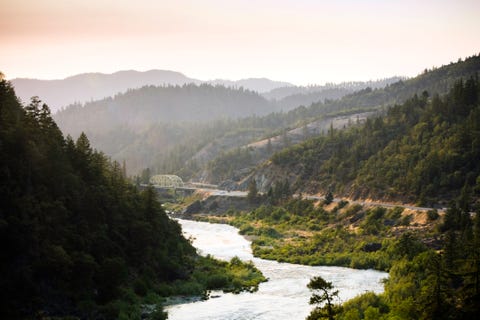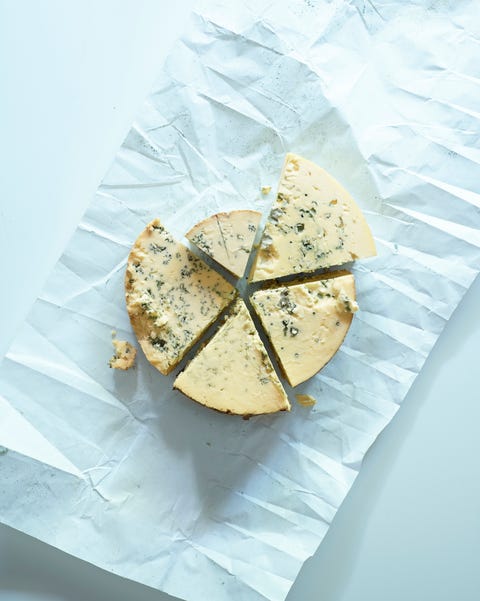Should I Get My Brain Back Old World Blues

DON PENNY/STUDIO D
I asked for roquefort. "Try this instead," urged my cheesemonger. Glancing at the price, I told him he was crazy. No way, I told him, was I going to spend nearly $50 a pound for blue cheese. Or, for that matter, any cheese. "Just try it," he said, handing over a small shard that made me think of a cloudy sky with tantalizing streaks of blue.
As I put it in my mouth, a tsunami of sensations flooded through me; this was not like any cheese I had ever experienced. Soft as fudge, it had a sweet intensity. The first flavor was subtle—grass, perhaps?—then nuts and berries chimed in. These were soon joined by faint whispers of pear and a rumor of autumn leaves. The texture was equally amazing, velvet smoothness occasionally rocked by crunchy little crystalline bits.
"Can I have another taste?" I asked. And then, of course, I bought some. Like all great cheese, this one must be eaten in its proper season. And that season runs until the end of October, in Oregon's Rogue River Valley, one of the most beautiful places on earth.

Getty Images
In the fall, after the rains come, the grass along the Rogue grows more exuberant as it fills with tiny flowers, clover, herbs, and wild blackberries. The cows that feed on this lush grass give milk that is richer and higher in butterfat than at any other time of year. This is the milk that goes into Rogue River Blue.
After the cheese has been carefully crafted, the wheels are hidden away, deep in the creamery's cellars, to slowly ripen through the cool months of autumn, winter, and spring. Early the next summer, when grapes are ripening, the cheesemakers head down the road to Cowhorn, a biodynamic vineyard, to pick syrah leaves.
"We tried the leaves of other grapes," says cheesemaker David Gremmels, "but merlot and zinfandel didn't offer the notes we were seeking." Back at the creamery the grape leaves are macerated in organic pear liqueur (from another Oregon neighbor) and wrapped around the cheese. Snuggled into their brandy-soaked coats, the wheels are left to luxuriate a few more months and then released just before the autumn equinox.
In 2003, the first year he sold the cheese, Gremmels had the audacity to enter it in the United Kingdom's World Cheese Awards. To everyone's astonishment it was named World's Best Blue, beating venerable entries like roquefort (which has been made for at least a thousand years), stilton (whose lineage goes back to 1722), and gorgonzola (which can trace its origins to the Roman era). This was a huge leap forward for American blues.
Some compared it to the 1976 Judgment of Paris, when two California wines stunned the world by winning an international wine tasting. (One French judge was so appalled to discover that Stags' Leap cabernet had bested Mouton Rothschild and Haut-Brion that she tried to take her ballot back. She was even less pleased to learn that Château Montelena chardonnay had trounced a couple of classic French Burgundies.) American wines were finally getting some respect; now American blue cheese was having its moment.

Getty Images
"I didn't set out to be a cheesemaker," Gremmels says. "My partner and I wanted to open a local wine and cheese bar in Ashland. We went to visit legendary cheesemaker Ig Vella, whose family had been making cheese in the Rogue River Valley since the 1930s. Ig told me I was going to have to make the cheese myself—he was done."
The late Vella, a famously persuasive person, agreed to stay on to mentor the fledgling artisans. The Vellas had been making European-style blues, but Gremmels didn't want an imitation; he dreamed of a cheese that spoke of the land he stood on, one that reflected the terroir of southern Oregon.
Now Gremmels has upped the ante. This year, for the first time, Rogue River Blue is entirely organic, made from the milk of his own herd. Eating the cheese, one can easily imagine the cows, high up in the clean air of the Oregon mountains, looking down at green fields and rushing waters.
Eat it slowly. Savor it. Pour yourself a glass of white wine (viognier or gewürztraminer are perfect pairings). Remember, another year will have to pass before this season comes again.
This story appears in the October 2017 issue of Town & Country.
Ruth Reichl Contributing Editor Reichl is an award-winning writer and editor.
This content is created and maintained by a third party, and imported onto this page to help users provide their email addresses. You may be able to find more information about this and similar content at piano.io
Should I Get My Brain Back Old World Blues
Source: https://www.townandcountrymag.com/leisure/dining/a12108741/blue-cheese-ruth-reichl/
0 Response to "Should I Get My Brain Back Old World Blues"
Post a Comment